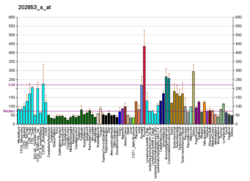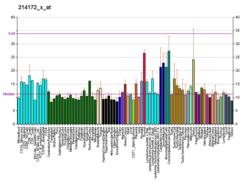Related to receptor tyrosine kinase
The related to receptor tyrosine kinase (RYK) gene encodes the protein Ryk.
The protein encoded by this gene is an atypical member of the family of growth factor receptor protein tyrosine kinases, differing from other members at a number of conserved residues in the activation and nucleotide binding domains. This gene product belongs to a subfamily whose members do not appear to be regulated by phosphorylation in the activation segment. It has been suggested that mediation of biological activity by recruitment of a signaling-competent auxiliary protein may occur through an as yet uncharacterized mechanism. Two alternative splice variants have been identified, encoding distinct isoforms.[5]
History
The gene encoding mouse RYK was first identified in 1992.[6] Subsequently, cDNA encoding the RYK protein have been isolated from the following species.[7]
Structure
In common with other receptor tyrosine kinase family members, RYK is composed of three domains, an N-terminal, extracellular ligand-binding domain, a transmembrane spanning domain and a C-terminal intracellular domain. However, in contrast to other receptor tyrosine kinases the C-terminal domain of RYK is devoid of detectable kinase activity.[7]
Function
RYK is involved in regulation of axon growth during development of the nervous system.[8]
References
- GRCh38: Ensembl release 89: ENSG00000163785 - Ensembl, May 2017
- GRCm38: Ensembl release 89: ENSMUSG00000032547 - Ensembl, May 2017
- "Human PubMed Reference:". National Center for Biotechnology Information, U.S. National Library of Medicine.
- "Mouse PubMed Reference:". National Center for Biotechnology Information, U.S. National Library of Medicine.
- "RYK receptor like tyrosine kinase [ Homo sapiens (human) ]". National Center for Biotechnology Information, U.S. National Library of Medicine. 13 March 2020. Retrieved 2 April 2020.
- Hovens CM, Stacker SA (1992). "RYK, a receptor tyrosine kinase-related molecule with unusual kinase domain motifs". Proc. Natl. Acad. Sci. USA. 89 (24): 11818–11822. doi:10.1073/pnas.89.24.11818. PMC 50648. PMID 1334548.
- Halford MM, Stacker SA (2001). "Revelations of the RYK receptor". BioEssays. 23 (1): 34–45. doi:10.1002/1521-1878(200101)23:1<34::AID-BIES1005>3.0.CO;2-D. PMID 11135307.
- Hollis ER, Ishiko N, Yu T, Lu CC, Haimovich A, Tolentino K, Richman A, Tury A, Wang SH, Pessian M, Jo E, Kolodkin A, Zou Y (2016). "Ryk controls remapping of motor cortex during functional recovery after spinal cord injury". Nature Neuroscience. 19: 697–705. doi:10.1038/nn.4282. PMC 4847956.
Further reading
- Partanen J, Mäkelä TP, Alitalo R, et al. (1991). "Putative tyrosine kinases expressed in K-562 human leukemia cells". Proc. Natl. Acad. Sci. U.S.A. 87 (22): 8913–8917. doi:10.1073/pnas.87.22.8913. PMC 55070. PMID 2247464.
- Gough NM, Rakar S, Hovens CM, Wilks A (1995). "Localization of two mouse genes encoding the protein tyrosine kinase receptor-related protein RYK". Mamm. Genome. 6 (4): 255–6. doi:10.1007/BF00352411. PMID 7613029.
- Lee ST, Strunk KM, Spritz RA (1993). "A survey of protein tyrosine kinase mRNAs expressed in normal human melanocytes". Oncogene. 8 (12): 3403–3410. PMID 8247543.
- Stacker SA, Hovens CM, Vitali A, et al. (1993). "Molecular cloning and chromosomal localisation of the human homologue of a receptor related to tyrosine kinases (RYK)". Oncogene. 8 (5): 1347–1356. PMID 8386829.
- Tamagnone L, Partanen J, Armstrong E, et al. (1993). "The human ryk cDNA sequence predicts a protein containing two putative transmembrane segments and a tyrosine kinase catalytic domain". Oncogene. 8 (7): 2009–2014. PMID 8390040.
- Wang XC, Katso R, Butler R, et al. (1996). "H-RYK, an unusual receptor kinase: isolation and analysis of expression in ovarian cancer". Mol. Med. 2 (2): 189–203. PMC 2230112. PMID 8726462.
- Katso RM, Russell RB, Ganesan TS (1999). "Functional analysis of H-Ryk, an atypical member of the receptor tyrosine kinase family". Mol. Cell. Biol. 19 (9): 6427–6440. PMC 84612. PMID 10454588.
- Trivier E, Ganesan TS (2002). "RYK, a catalytically inactive receptor tyrosine kinase, associates with EphB2 and EphB3 but does not interact with AF-6". J. Biol. Chem. 277 (25): 23037–43. doi:10.1074/jbc.M202486200. PMID 11956217.
- Strausberg RL, Feingold EA, Grouse LH, et al. (2003). "Generation and initial analysis of more than 15,000 full-length human and mouse cDNA sequences". Proc. Natl. Acad. Sci. U.S.A. 99 (26): 16899–903. doi:10.1073/pnas.242603899. PMC 139241. PMID 12477932.
- Brandenberger R, Wei H, Zhang S, et al. (2005). "Transcriptome characterization elucidates signaling networks that control human ES cell growth and differentiation". Nat. Biotechnol. 22 (6): 707–16. doi:10.1038/nbt971. PMID 15146197.
- Lu W, Yamamoto V, Ortega B, Baltimore D (2004). "Mammalian Ryk is a Wnt coreceptor required for stimulation of neurite outgrowth". Cell. 119 (1): 97–108. doi:10.1016/j.cell.2004.09.019. PMID 15454084.
- Watanabe A, Akita S, Tin NT, et al. (2006). "A mutation in RYK is a genetic factor for nonsyndromic cleft lip and palate". Cleft Palate Craniofac. J. 43 (3): 310–6. doi:10.1597/04-145.1. PMID 16681403.
- Szafranski K, Schindler S, Taudien S, et al. (2007). "Violating the splicing rules: TG dinucleotides function as alternative 3' splice sites in U2-dependent introns". Genome Biology. 8 (8): R154. doi:10.1186/gb-2007-8-8-r154. PMC 2374985. PMID 17672918.






